Average sizes and life expectancy for this breed:
English Bulldogs are loved for their distinctive physical appearance and gentle natures. They are medium-sized dogs with low-slung and thick-set bodies. Their short-muzzled head is large in proportion to the body and square. They also have broad shoulders and chests, with dense, robust limbs.
Despite being depicted as ferocious dogs in cartoons, today's English Bulldogs are bred to be loving and sweet-natured. This dog breed is determined and courageous. They also tend to be very protective over their families which makes them great watchdogs. In general, English Bulldogs are playful and adore people. In fact, they have been known to actively pursue people for a bit of love and attention.
The English Bulldog is a popular dog breed the world over. However, they are not suitable for everyone due to their large size and hefty weight. These dogs are not easy to lift! They can also be stubborn at times so require regular training.
When at home, English Bulldogs are known for being fairly lazy. They will happily lounge all day until it’s time to eat again. However, it’s important for these dogs to get regular exercise to prevent obesity and joint problems.
These muscular little powerhouses give the impression of strength, stamina, and determination. They make good family pets as they adore the attention they receive from children.
See available puppies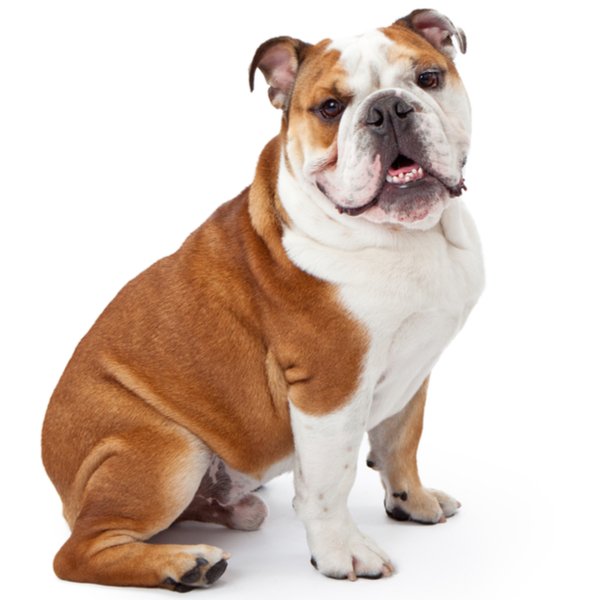

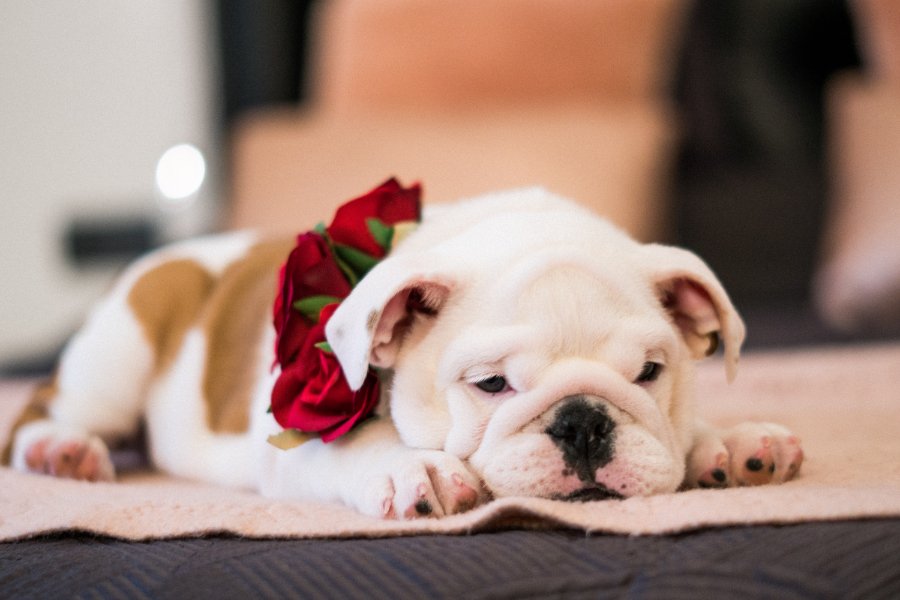


Today’s English Bulldog is a very different canine compared to their ancestors. Originating from the ancient mastiff-type dogs, this dog breed was entirely developed in England. The first mention of the English Bulldog was in 1500 in a description of a man "with two Bolddogges at his tayle..." However, they could date right back to the 5th century and a breed called the Alaunt.
They were originally used to catch large animals such as horses, boar, and cattle on farms. However, in the 15th century, they were also famously used in a brutal sport known as bullbaiting. This involved training dogs to grab hold of a tethered bull’s nose and not let go until the animal had been pulled to the ground or killed.
Until 1835, when bullbaiting was finally outlawed in England, Bulldogs were exclusively bred for this type of aggression. So, when the sport ended, many people felt there was no need for this breed to continue as they were seen as aggressive and not suitable as companions. In fact, the breed could have gone entirely extinct if it wasn’t for their exportation to America and Germany. In America, the bulldog found a new purpose, helping out on rural farms. In Germany, they were eventually crossed to create the Boxer breed.
Despite their negative reputation, Bulldogs finally grew in popularity as companion animals, including in the UK. In 1859, breeders started exhibiting English Bulldogs in conformation shows in England. In 1860, Bulldogs appeared in their first dog show in Birmingham, England.
Today, these dogs are loved for their gentle demeanours and representation of strength and fierce loyalty. In fact, they are commonly used as mascots for a range of universities, sports clubs, schools, and other companies, including the US Marines.
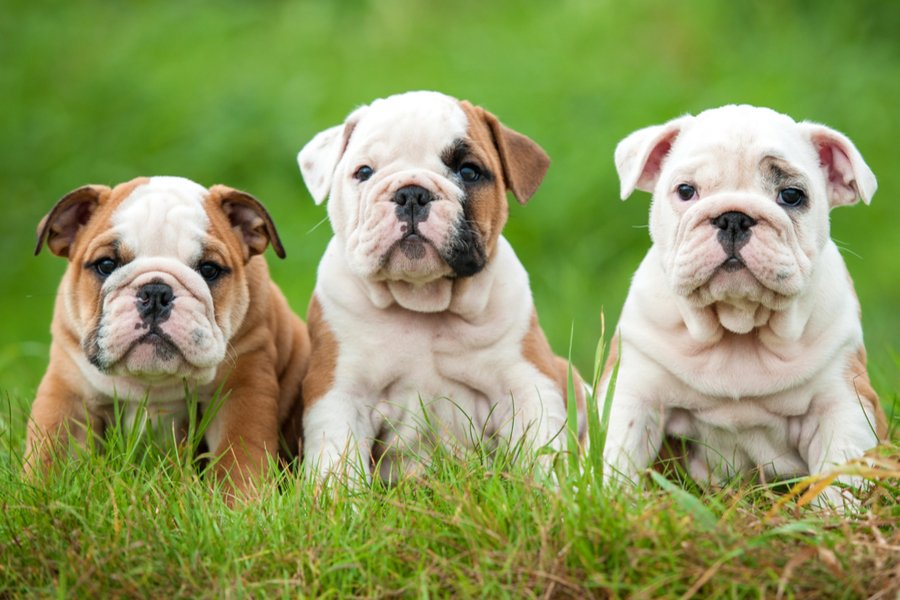
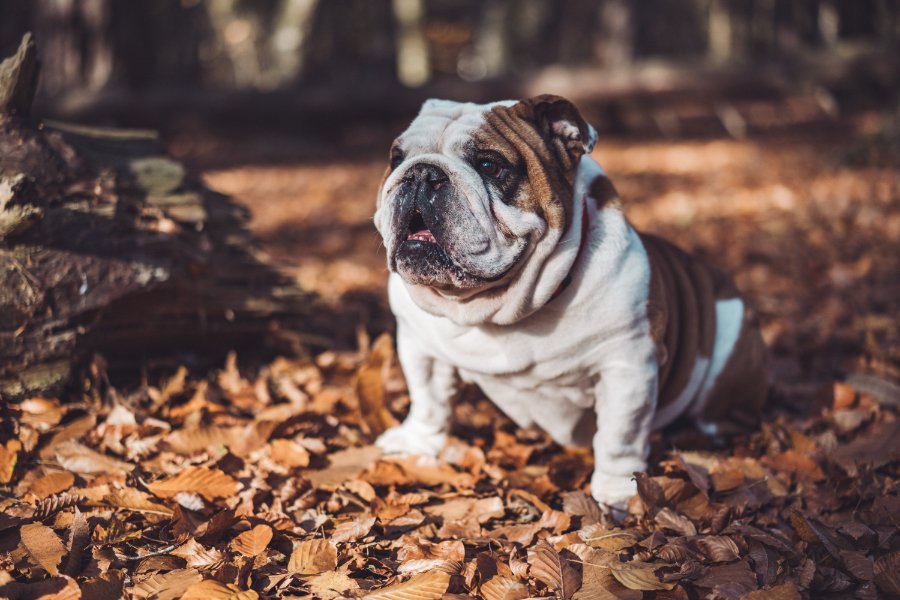
An English Bulldog's head is large and square. These dogs have extremely short muzzles, giving their faces a flattened appearance. Their dark eyes are set low and wide on the head and there are distinct wrinkles on the forehead. Their black noses are somewhat upturned with large nostrils. Their massive jaws are wide and undershot, with fleshy lips that overhang. These dogs also have well-rounded cheeks that protrude sideways past the eyes. Their small ears are thin and angled forward like flaps.
The strong neck of the English Bulldog is short and thick with loose skin around the throat that forms slight dewlaps on either side. Their muscular shoulders are massive and broad. Their chests are deep and full, giving a robust, stocky appearance. Their muscular hindquarters are slightly longer than their front legs, with stifles that turn out away from the body slightly.
A distinct physical characteristic of this breed is a slight fall to the back, just behind the shoulders. The spine should rise to the loins and then curve again near the tail. The tail itself is thick at the base and set low and straight, with a downward curve towards the tip.
The English Bulldog has a sweet, sociable, and calm nature. They are reliable and predictable, which makes them wonderful family pets and excellent watchdogs. Moreover, they are very loving towards children. However, they do have a stubborn streak that needs to be kept in check with regular training.
These comical dogs are easygoing and friendly; they get along well with pretty much everyone! They are not known to be highly intelligent dogs, but you can guarantee they will do their best to please you. Once they learn a command, they will retain it for life.
As they grow, English Bulldogs develop a calm dignity when appropriately trained but they maintain their playful and friendly natures throughout their lives. They often seek human attention and enjoy snuggling with their human companion whenever they can, snoring away to dreamland. These dogs can be left alone for a few hours but bear in mind that they thrive on human affection.
It’s worth noting that bulldogs can be wary of other dogs, due to their history as bullbaiters. However, with appropriate socialisation they can learn to get along with other dogs.
English Bulldogs only need a moderate amount of exercise daily. They flourish in temperate climates but bear in mind that they can easily overheat and have breathing difficulties in hot weather.
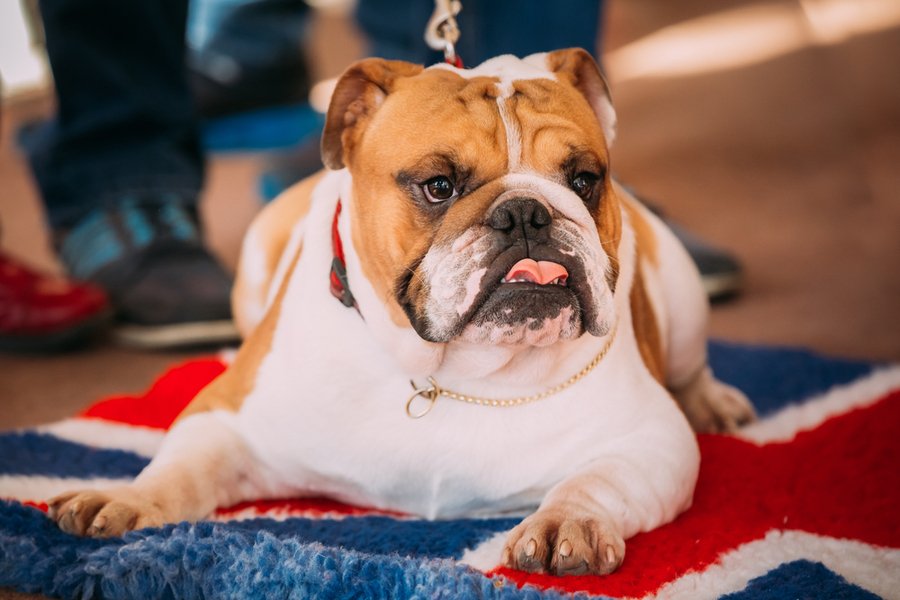
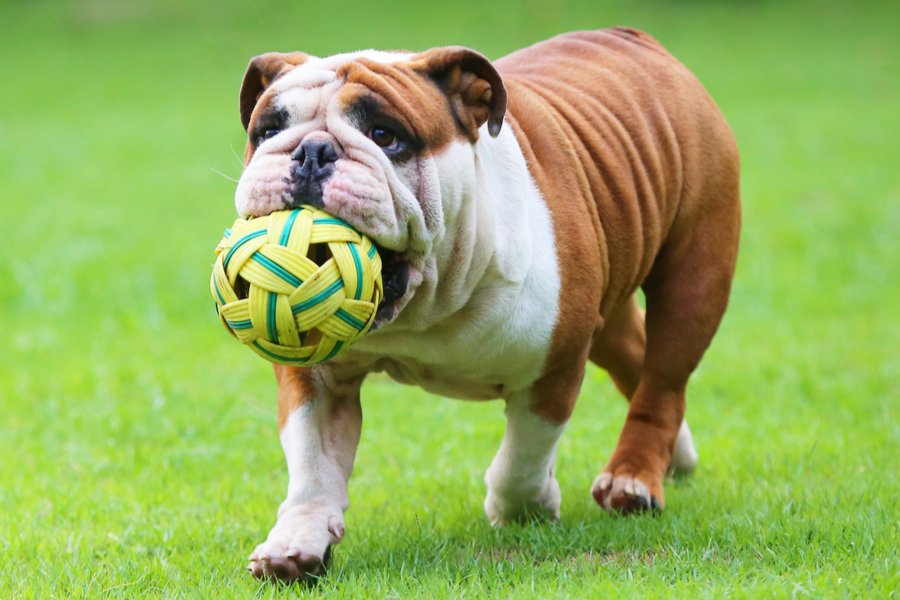
English Bulldogs are kind, loyal, and laid back about life. However, like all dog breeds, early socialization and training are essential. In fact, many dog owners highly suggest puppy training classes. This will also allow new dog owners to acquire more information about this wonderful breed.
English Bulldogs love to chew so provide them with multiple safe chew toys. They also enjoy playing tug-of-war. Just make sure to teach your Bulldog puppy to release what's in their mouths on command.
These dogs usually learn best from fun training sessions which include repetition and positive reinforcement through treats and praise. Despite their size, they can be sensitive to harsh commands and may just point-blank refuse to cooperate. Make sure you also keep training sessions short. Up to 10 minutes for each session is more than enough.
Keep your English Bulldog looking their best by brushing them with a soft (ish) bristle brush at least once a week. However, 2-3 times a week may be needed, especially during shedding seasons. You can also use a rubber brush to eradicate any loose fur before grooming. Luckily, Bulldogs tend to love being groomed as it gives them one on one time with their favourite human companions.
Regularly check and clean your English Bulldog’s face, especially the wrinkled parts, as food and moisture can get trapped and cause irritation. Make sure to check their ears regularly too and the area under their tail. The outer part of their ears can be wiped out with a soft cloth and a PH-balanced ear cleaner specifically designed for dogs.
English Bulldogs are frequently inactive indoors and they do not need a substantial amount of exercise compared to other dog breeds. However, you must still walk them every day for a least 20 minutes to keep them from gaining unnecessary weight.
English Bulldogs do not do well in extremely hot or cold weather because of their abnormally flattened faces (known as brachycephaly). They breathe heavily when they are hot and don't disperse heat well. So, they are also prone to heatstroke. Provide them with an air-conditioned environment and encourage them to drink fresh, clean water regularly. They should also not be left outside without access to shade and water
If an English Bulldog is overexcited, hyper, or breathing too fast, their tongue will hang out too far and have a bluish cast rather than the normal pink. If this happens, immediately soak them in cool water and give them ice to help them cool down.
In addition, you will also want to ensure you trim their nails regularly as bulldogs don’t tend to wear them down naturally. Furthermore, it’s a good idea to check over the whole body during grooming for any signs of a health condition such as redness, swelling, irritation, or abnormal discharge.
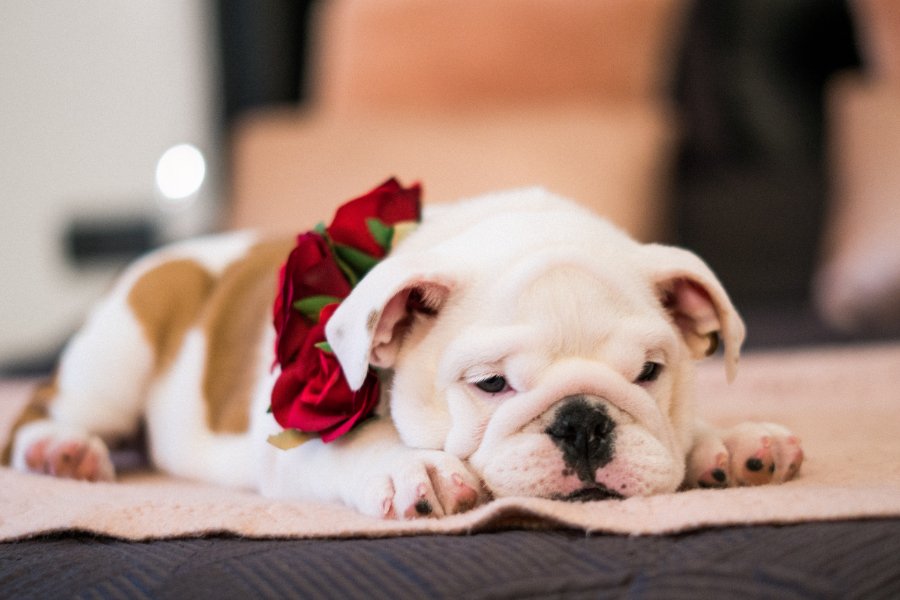
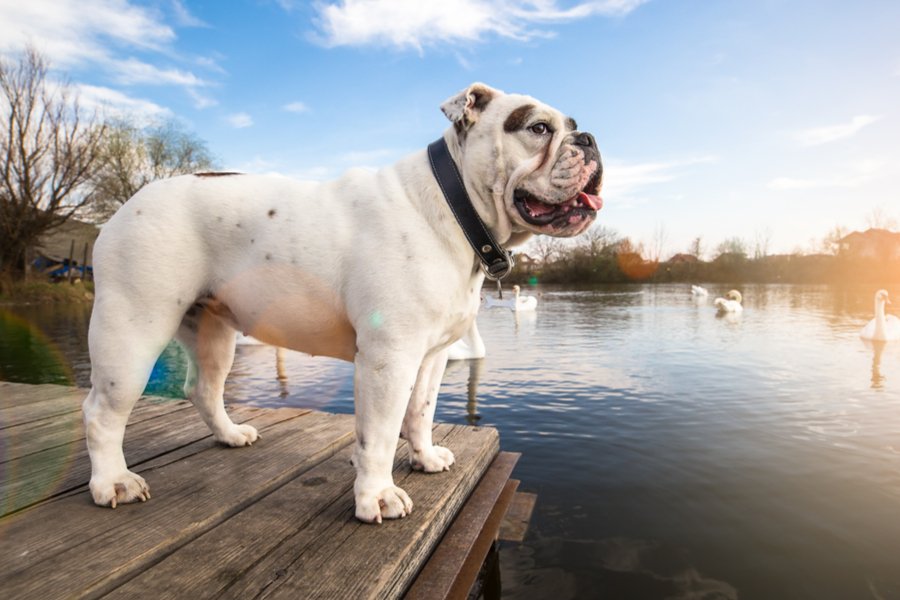
English Bulldogs have a unique body and head structure that can make them prone to developing a number of health problems, especially respiratory and joint issues. They can also become overweight very quickly if they don't get adequate exercise, which can exacerbate existing conditions. Always purchase a Bulldog from a licensed and reputable breeder to ensure they have been appropriately cared for and weaned. A professional breeder will also perform DNA tests to check for any underlying conditions that may affect their health later in life.
English Bulldogs are loved for their goofy and friendly personalities, which makes them very family friendly. However, it is still recommended to supervise any interaction between your English Bulldog and a child to avoid any mishaps that may happen because of mishandling.
English Bulldogs also generally get along well with other pets, such as dogs and cats. However, because of their background, this dog breed may be less friendly to unfamiliar dogs. Always introduce new pets with care to avoid any aggressive or territorial behaviour.
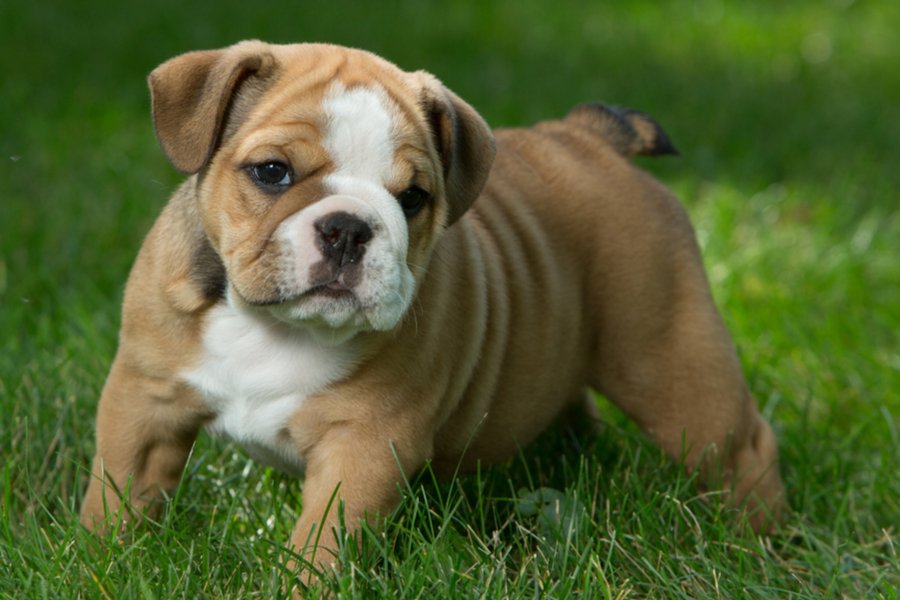

We can connect you with Breeders that are specialized in this particular breed.
See available puppies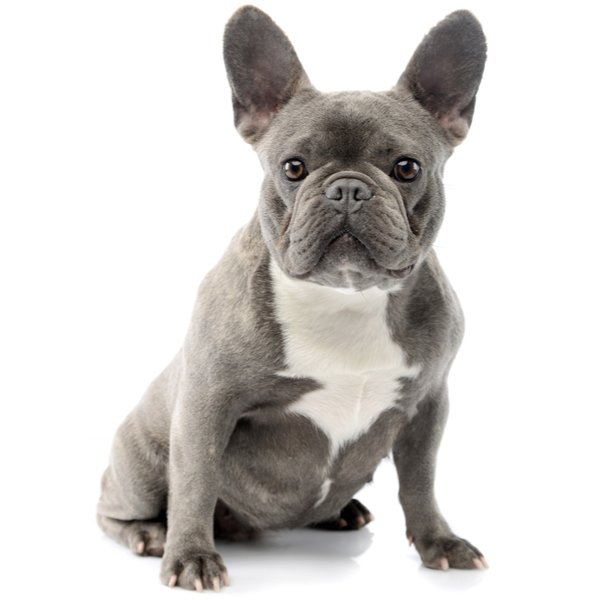
France
Size : Medium
Coat : Short
Registration : KC, FCI, AKC
Exercise : 30 minutes
Training : Medium
Grooming : Once a Week


Need some advice?
Whether you're a first time pet owner, an experienced pet owner, a new or long-time breeder, or just curious about pets, we've got you covered!

January 17, 2024
What Is The Personality Of Russian Blue Cats?
Russian Blue cats are most known for their distinctive shimmery blue-silver coat and piercing green eyes. However, this breed’s calm and gentle temperament is what makes them shine the most in the feline world.

January 17, 2024
10 Facts About Russian Blue Cat Breed
Russian Blues are one of the most aesthetically stunning cat breeds, with a gorgeous plush silvery coat and vibrant green eyes. However, it’s not only their appearance that is beautiful; their nature is too.

January 17, 2024
How To Choose The Right Cat Breed for You
Cats can make the most fantastic animal companions; they are adorable, friendly, and loving. However, not all felines are created equal. There are many different breeds, of which each has its unique personality traits.
Need some help?
Contact us to speak to our friendly advisor, who will gladly help you find your dream pet!



We are registered in England and Wales under registration number 12568840,
and our registered office is at 58-60 Kensington Church Street, W8 4DB London, England.
© 2023 The Pedigree Paws